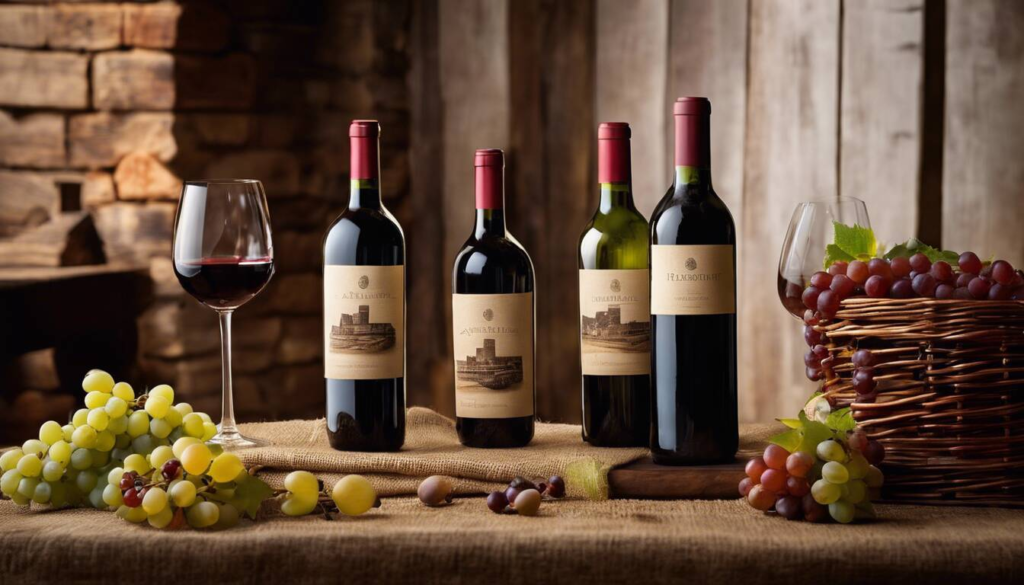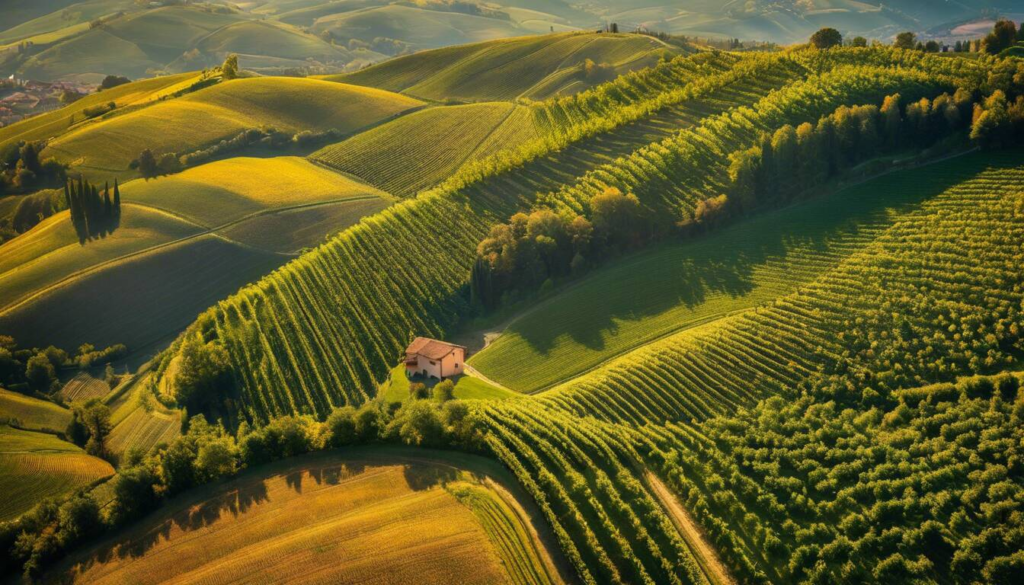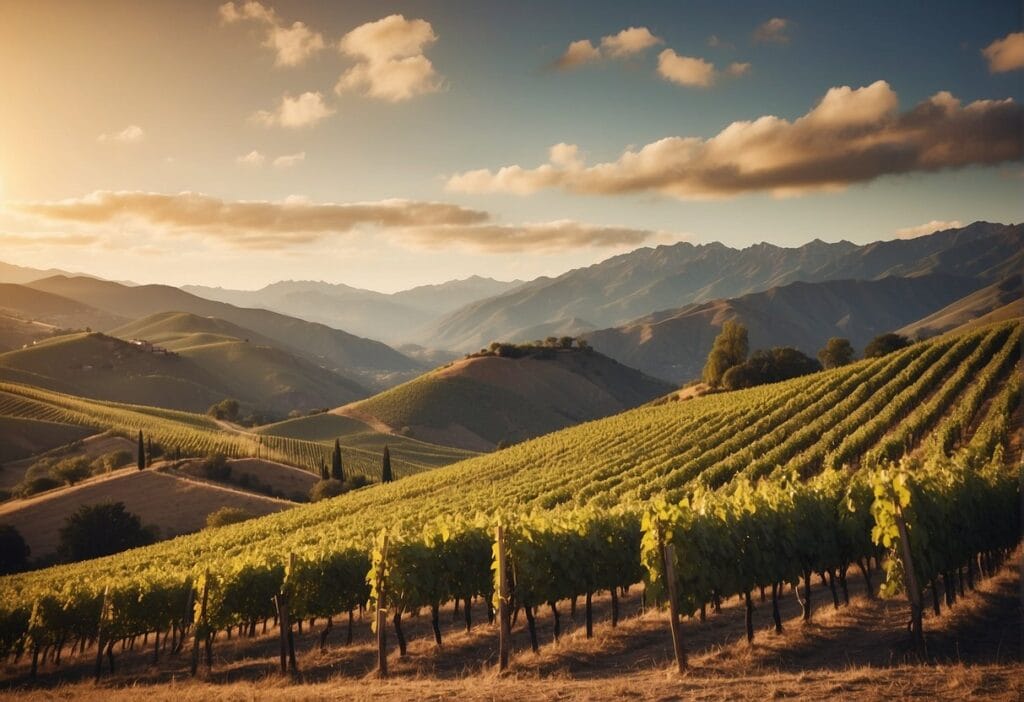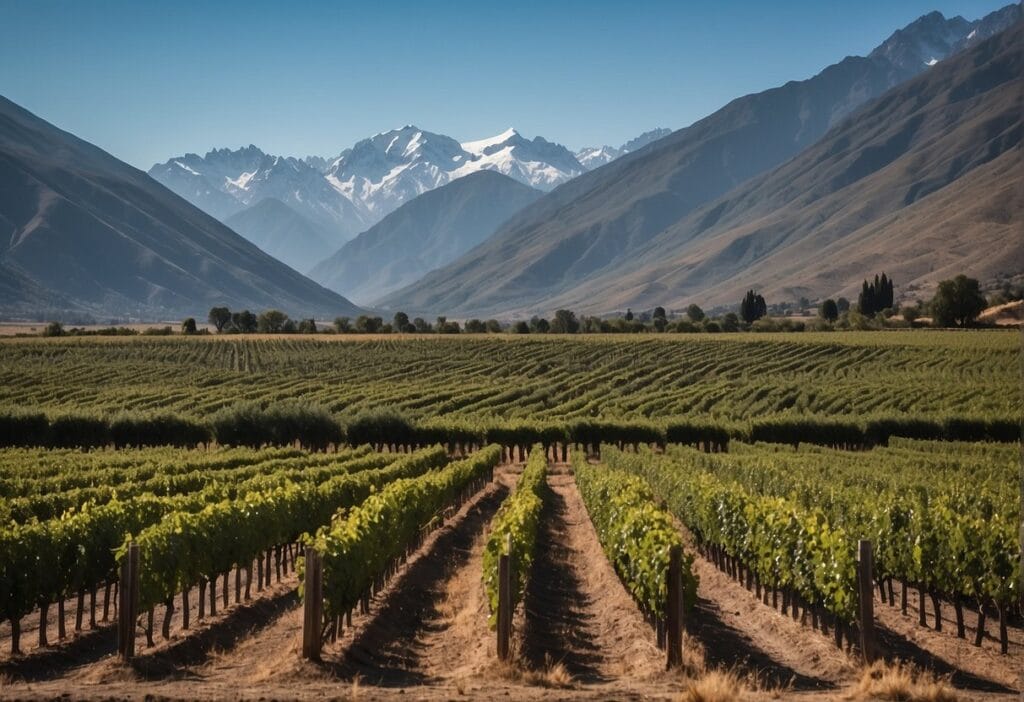Piedmont, situated in northwest Italy, is a treasure trove known for its world-class wines. Particularly revered are varietals from Nebbiolo, Barbera, and Dolcetto grapes—the region’s notable heroes. The magic comes from Piedmont’s unparalleled geography, where mountain air collides with Mediterranean influence, bringing forth wines that are anything but commonplace. With areas like Barolo and Barbaresco under its belt—both UNESCO World Heritage Sites—it’s little wonder why Piedmont is a sought-after destination for wine connoisseurs globally. Now let’s uncork Piedmont’s riches.
Some of the most famous wines from the Piedmont region include Barolo, Barbaresco, and Barbera. These wines are celebrated for their unique expressions of site and climate, making them highly sought after by wine enthusiasts worldwide.

Piedmont: A Region of Famous Wines
Situated in the northwest of Italy, Piedmont is renowned for not only its picturesque landscapes but also for yielding some of the world’s most remarkable wines. At the heart of this region is the Nebbiolo grape variety, which takes the spotlight to produce the esteemed Barolo and Barbaresco wines, revered for their complexity and unmatched aging potential.
The Nebbiolo grape is frequently compared to Pinot Noir due to its transparency and its adeptness at reflecting the unique terroir of the region. Nowhere is winemaking tradition more pronounced than in the “King of Wines” – Barolo. This regal wine has earned UNESCO World Heritage status for its significant cultural impact and its extraordinary expressiveness. What sets Barolo apart is the specific geographical area where it’s cultivated, comprising 11 different villages, each imprinting its own characteristics on the wine based on soil types and microclimates.
Conversely, Barbaresco, with its limestone-rich soils, produces wines with a lighter profile, lower tannins, and an emphasis on elegant red fruit flavors. The contrast between these two revered regions is not just to be savored in a glass but also offers an opportunity to explore the diverse expressions that Nebbiolo can display.
In addition to Nebbiolo, Barbera asserts itself as the most widely planted grape in Piedmont. Flourishing in the region’s hilly vineyards, it infuses its ruby-hued wines with vibrant cherry flavors and softer tannins compared to Nebbiolo. Two distinguished appellations worth noting are Barbera d’Asti DOCG and Barbera d’Alba DOC. These designations underscore the superior quality of specific areas within Piedmont where Barbera thrives.
Finally, Dolcetto commands recognition as another significant red grape variety in Piedmont. Renowned for its pronounced fruitiness, deep color, and moderate-to-low acidity, Dolcetto offers a delightful contrast to the more structured Nebbiolo wines typically associated with this region. Its earlier ripening cycle allows it to flourish on sun-soaked slopes or higher elevations that may not be ideal for growing Nebbiolo.
By exploring the unique characteristics of these major grape varieties in Piedmont, we gain a deeper understanding of the distinct qualities that define this remarkable wine region.
As we uncork the essence of Piedmont’s famous wines and delve into their distinctive tastes and pairings, we can now turn our attention to exploring two iconic offerings—Barolo and Barbaresco.
Diving into Barolo and Barbaresco
When discussing the Piedmont region, two names that often come to mind are Barolo and Barbaresco. These wines are highly regarded, not just in Italy but on the global stage as well. Both are crafted from the Nebbiolo grape, which is renowned for its transparency and sense of place, akin to the Pinot Noir. Let’s explore these exceptional wines and uncover their distinct qualities.
Barolo, often referred to as the “King of Wines,” earns its title with good reason. This robust red wine is celebrated for its deep, complex flavors and significant tannins. The Nebbiolo grape gives rise to tasting notes that include red cherry, roses, truffles, and tar, presenting a rich sensory journey with every sip. These intense flavors make it a perfect match for hearty dishes like braised meats, truffle-infused risottos, and aged cheeses.
Barbaresco, on the other hand, exudes elegance and refinement. With a lighter body compared to Barolo, it offers a velvety texture complemented by flavors of raspberry, violets, and subtle earthy undertones. This delicate balance makes it a versatile companion for a variety of dishes, particularly roasted poultry, mushroom-based recipes, and creamy risottos.
Beyond just its flavor profile, what sets these wines apart is their origin; Barolo is cultivated in the eponymous village of Barolo, part of an area designated as a UNESCO World Heritage site. On the other hand, Barbaresco is primarily produced in the town of Barbaresco. These unique geographical factors contribute to specific characteristics found only in wines produced in these designated regions—a testament to the intrinsic link between terroir and wine quality.
Imagine savoring a glass of Barolo while indulging in a sumptuous truffle risotto or relishing a bottle of Barbaresco alongside a perfectly roasted duck. Each sip accentuates the aromas and flavors of these delectable dishes while enlivening your palate with an unparalleled taste sensation—an experience that speaks volumes about the remarkable pairing potential of these wines.
Intriguingly enough, Piedmont’s wine landscape extends far beyond the well-known territories of Barolo and Barbaresco. Now let’s venture into an underrated gem amidst this abundant viticultural panorama—San Roero.
San Roero: An Underrated Wine Region
Nestled among the renowned wine regions of Piedmont is the equally captivating San Roero. Sheltered within the Roero district, San Roero is gradually earning acclaim for its aromatic white wines fashioned from the indigenous Arneis grape. The sandy soils, influenced by the nearby Tanaro River, instill these wines with a distinctive minerality and invigorating quality.
San Roero is akin to a hidden oasis waiting to be unearthed. Its wines exude a radiance that is unrivaled, owing to the unique terroir of this locale. The sandy soils endow the Arneis grape with a delicate floral and fruity essence, yielding wines with bright acidity and an irresistible freshness. These attributes make San Roero wines an ideal accompaniment for seafood and vegetarian dishes. Imagine savoring a delightful meal of freshly grilled fish or a vibrant vegetable risotto, enveloped by friends and family, with a glass of San Roero wine enhancing every bite.
Picturing yourself meandering through the vineyards on a warm summer’s day, feeling the gentle breeze from the Tanaro River while beholding the picturesque landscape that breathes life into these exceptional wines is an experience that lingers long after you’ve savored your last drop.
The allure of San Roero not only rests in its exquisite wines; it’s also the narrative behind each bottle that adds a layer of intrigue.
San Roero stands as a testament to how tradition intersects artisanal craftsmanship. The vintners here possess an intimate knowledge of their land, handed down through generations. Every bottle narrates a story of dedicated cultivation and meticulous care at every stage of production.
San Roero beckons with its enchanting commitment to quality and heritage, presenting a taste of Piedmont’s enigmatic allure distinct from any other region.
As we venture forth in our exploration of Piedmont’s wine tapestry, we now turn our attention to uncovering the diverse array of quality wine varietals that define this captivating region.
Quality Wine Varietals from Piedmont
Piedmont is home to some of the most prestigious grape varieties in the world, each contributing distinct characteristics to the wines they produce. Let’s begin our exploration of these noble grape varietals with Nebbiolo, known as the “noble grape” of Piedmont.
Nebbiolo: The Noble Grape
Nebbiolo is a fascinating grape variety known for its transparent nature, allowing it to express the unique terroir of the region. When it comes to Nebbiolo wines, the standout stars are none other than the esteemed Barolo and Barbaresco. These wines showcase an impressive array of flavors, ranging from luscious raspberries and delicate roses to deep, earthy truffle notes. The complex and multi-layered character of Nebbiolo wines makes them both versatile and age-worthy, providing an exceptional drinking experience for connoisseurs and enthusiasts alike.
The elevation, soil composition, and microclimate nuances of Piedmont play pivotal roles in shaping the distinctiveness of Nebbiolo wines. It’s this dynamic interaction between geography and grape that grants Barolo and Barbaresco their esteemed status as enduring expressions of site-specific viticulture. By carefully crafting wines from Nebbiolo grapes, winemakers capture not only the essence of specific vineyard plots but also the broader context of Piedmont’s winemaking heritage.
Barbera: A Versatile Choice
In contrast to Nebbiolo, Barbera reigns as the most widely planted grape variety in Piedmont. Known for its vibrant acidity and bright cherry flavors, Barbera produces wines with softer tannins that are beloved for their food-friendly qualities. Its versatility at the dining table makes it an ideal companion for a wide range of cuisines, including classic pasta dishes adorned with rich tomato-based sauces, as well as succulent grilled meats. The inherent approachability and zesty character of Barbera wines make them beloved by both newcomers and seasoned wine enthusiasts.
Imagine sitting down to a hearty Italian meal with a glass of well-aged Barbera. The vibrant acidity and ripe fruit flavors effortlessly complement the savory tomato sauce of your pasta, harmonizing with every flavorful bite. This is where Barbera truly shines—it seamlessly integrates with various culinary experiences and consistently brings joy to those who partake in its pleasures.
Dolcetto: The Fruity Red
Lastly, we encounter Dolcetto—a significant red grape variety in Piedmont celebrated for its enchanting fruitiness, deep color, and moderate-to-low acidity. Dolcetto wines encompass a charming spectrum of youthful exuberance, often enjoyed as vibrant red wines brimming with lively fruit profiles. Distinguished by their captivating aromatics and supple textures, Dolcetto wines effortlessly elevate casual gatherings and pair beautifully with laid-back Italian fare, making them an essential presence on any charcuterie board.
As we journey through the scenic landscapes and rolling hillsides of Piedmont, it becomes evident that each wine varietal exudes its own captivating allure, enriching the diverse tapestry of regional winemaking traditions. Whether it’s the ethereal elegance of Nebbiolo or the convivial charm of Barbera and Dolcetto, these exceptional grape varieties stand as tributes to Piedmont’s timeless commitment to producing world-class wines that captivate hearts and palates alike.
Embarking upon our journey beyond tasting notes and into the heartlands where these exquisite varietals flourish, let’s now venture forth into exploring estates and vineyards spanning from Alba to Liguria.
Exploring Estates and Vineyards: Alba to Liguria

The journey through Piedmont’s charming towns and spectacular landscapes is a treat for wine lovers and travelers alike. Alba is a medieval town known for its splendid white truffles and world-renowned wines. It’s also home to prestigious wine estates like G.D. Vajra, Vietti, and Fratelli Revello, each offering guided tours, tastings, and an immersive experience that uncovers the rich heritage and winemaking traditions of Piedmont.
The Charms of Alba
Picture wandering through the picturesque streets of Alba, surrounded by rolling hills and embraced by the enticing aroma of truffles – an experience that is delightful and deeply connected to the region’s cultural identity. Some of the most influential wine producers in Italy reside in this idyllic setting, ready to share their passion for winemaking with curious visitors. The landscape is a symphony of colors – lush vineyards set against the backdrop of quaint villages, creating a scene straight out of a postcard.
The Wine Route to Liguria
Heading towards Liguria along the wine route treats you to a visual feast – breathtaking landscapes unfolding before your eyes, each bend in the road revealing a new vista more captivating than the last. This itinerary is tailored for wine enthusiasts who appreciate not only the fine art of winemaking but also the natural beauty that accompanies it. The vineyards that stretch as far as the eye can see are a testament to the region’s dedication to producing exceptional wines.
Immersive Tastings and Heritage Unveiled
Guided tours through these vineyards are akin to stepping back in time, where you can witness firsthand the age-old traditions of winemaking preserved over centuries. The experience is not merely about tasting exquisite wines; it’s about forging a connection with the land and its people. Each estate has its story to tell, a unique narrative that speaks volumes about the dedication, resilience, and unwavering commitment to producing top-quality wines.
For wine enthusiasts seeking a holistic wine-tasting experience steeped in tradition and charm, exploring these estates offers an unrivaled opportunity to savor the very essence of Piedmont’s viticultural prowess.
Tasting Notes and Food Pairing Tips for Piedmont Wines
Tasting Notes and Food Pairing Tips for Piedmont Wines
Piedmont wines are renowned for their rich and complex flavors that mirror the region’s unique terroir. When it comes to tasting these exceptional wines, an abundance of aromas and flavor profiles await exploration, each offering a distinct experience. Let’s start by delving into some tasting notes for these iconic varieties.
Barolo
Barolo is often hailed as the “King of Wines” owing to its bold and robust character. When you pour yourself a glass, take a moment to appreciate its deep garnet hue and the seductive aromas of cherries, roses, and a hint of earthiness. The taste is equally captivating, with intense flavors of red fruits, tar, and a subtle note of truffle.
Quick Tip: Take notice of its prominent tannins – those slightly bitter compounds that give structure to the wine. These tannins are what make Barolo such a perfect match for rich, flavorful dishes.
Food Pairing: This regal wine pairs splendidly with equally bold dishes. Consider indulging in a luscious truffle risotto or savoring a tender braised beef dish. The deep flavors of Barolo complement these robust flavors exceptionally well, creating an unforgettable dining experience.
Barbaresco
Similar to its counterpart Barolo, Barbaresco offers a mesmerizing sensory journey with its alluring aromas and refined taste profile. Pouring a glass reveals an enchanting ruby color with scents of ripe berries, violets, and delicate spices. The first sip unveils elegant flavors of cherry, raspberry, and a whisper of licorice.
Pro Tip: Allow this wine to breathe before sipping on it – it will truly open up and reveal its full character.
Food Pairing: Pair this distinctive wine with lighter yet flavorful dishes. A roast duck would be an excellent choice, allowing the delicate flavors of the meat to harmonize with the intricate nuances of Barbaresco. For a vegetarian option, consider embracing the earthy essence of this wine alongside a delectable truffle risotto.
As we continue our exploration into the tantalizing world of Piedmont wines, let’s uncover the delightful flavor profiles of Barbera and Dolcetto, along with their perfect food pairing companions.
The Piedmont region holds a treasure trove of wines waiting to be discovered. From the grandeur of Barolo to the elegance of Barbaresco, each sip unveils centuries of tradition and craftsmanship. Cheers to your next wine adventure!

